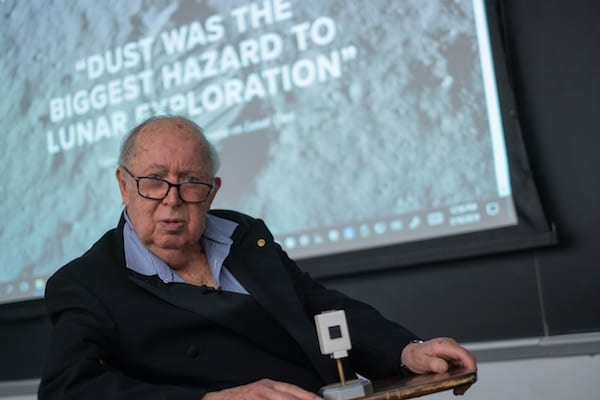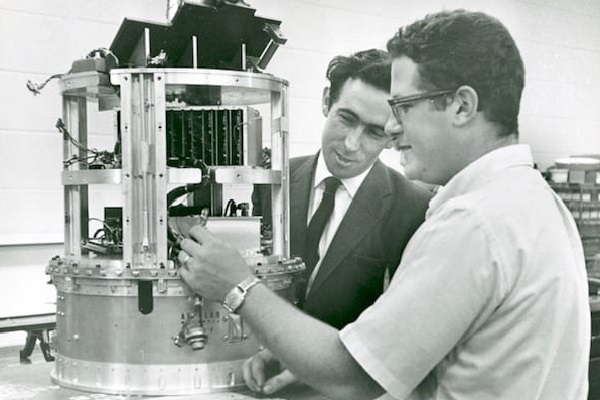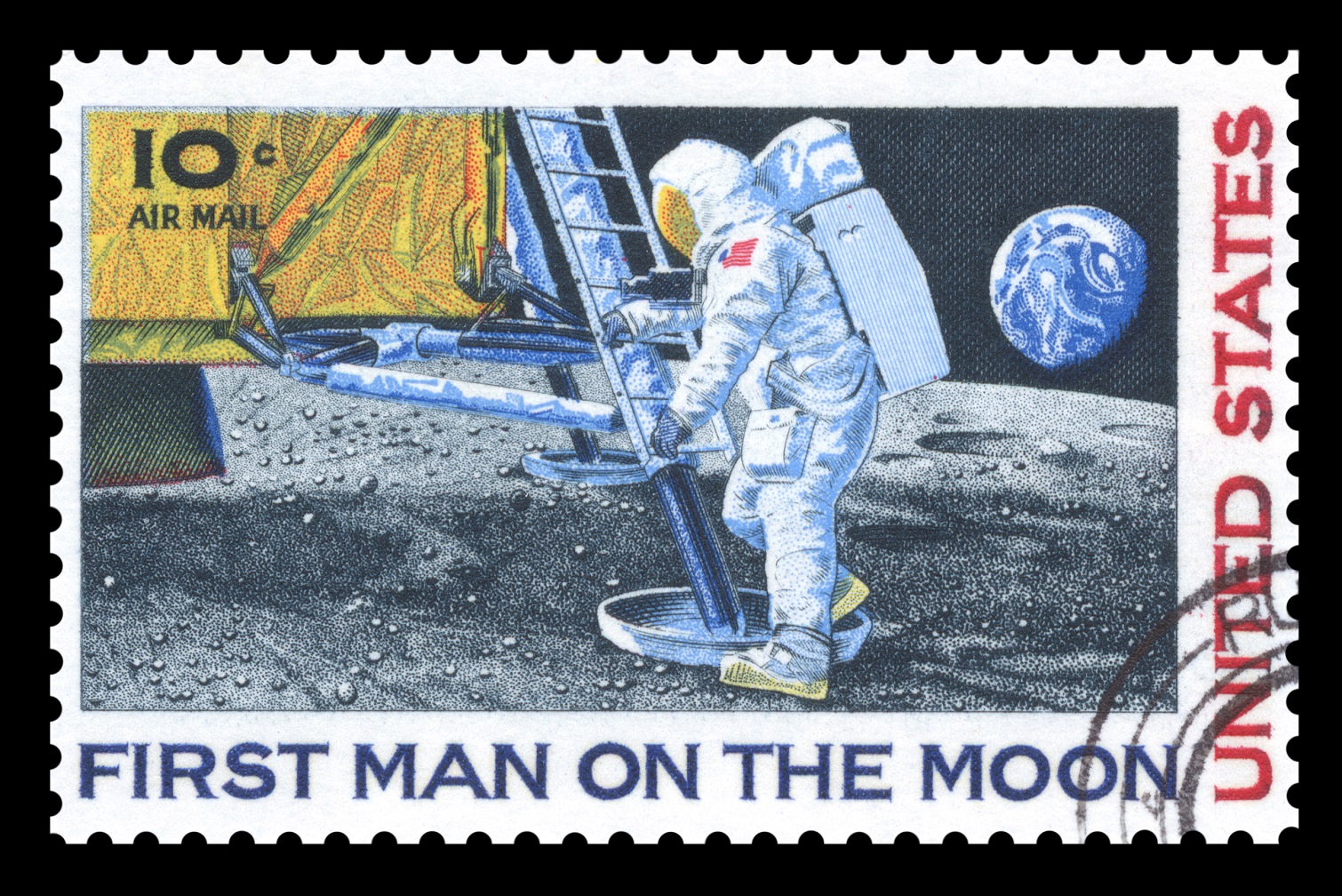With the 50th anniversary of the first human landing on the Moon approaching, we pay tribute to the role played by one of our Fellows, Professor Brian O’Brien FTSE.
The moment Brian O’Brien knew he’d hit pay dirt came when Buzz Aldrin told him so – from a quarter-million miles away.
“The thrill of the Apollo 11 landing for me was when Buzz was commenting, something like 40 feet above the moon, on strikes due to dust,” O’Brien said. “Then I knew the whole thing was worthwhile.”
Until that moment nearly 50 years ago, he said, nobody was absolutely sure the moon lander wouldn’t sink beneath the lunar surface, astronauts and all.
O’Brien, a Rice University professor from 1963 to 1968, returned to campus from his native Australia on March 18 to give a pair of talks, first to scientists and later to the public as part of the Space Frontiers Lecture Series sponsored by the Rice Space Institute, about the implications of dealing with moon dust.
From one perspective, he was merely one of 400,000 people who got Apollo 11 and subsequent missions to the moon. But O’Brien, a founding father of Rice’s groundbreaking Space Science Department, had the unique distinction of placing five experiments in two different scientific disciplines — radiation and dust — on missions spanning the first landing to Apollo 15.
His primary focus early on was the Charged Particle Lunar Environment Experiment (CPLEE), which measured plasma-energy electrons and protons, extending his research into the solar radiation that causes Earth’s aurora borealis. It was chosen as one of the original seven experiments to be deployed for long-term observation on the moon.
O’Brien became so concerned that lunar dust would affect CPLEE that he designed an eighth, the tiny Dust Detector Experiment (DDE) that flew on Apollo 11 through 15.
The detectors were 270-gram Plexiglas boxes with solar cells attached to the ALSEP packages on Apollo 12, 14 and 15, wired to feed voltage data to the package’s transmitter. Dust on the cells dropped the voltage and gave scientists an accurate measure of accumulation.
The original DDE deployed as part of Apollo 11’s smaller EASEP package was turned off after 21 days when the cohabiting seismometer overheated — as O’Brien had predicted — because of moon dust blown onto the instruments when the lunar module blasted off. But the units on Apollo 12, 14 and 15 continued to transmit until the last working experiments were shut down in September 1977.
With the 50th anniversary of Apollo 11 approaching, O’Brien is out to set the record straight about problems moon dust will likely pose for astronauts or, eventually, residents of the moon. Aside from his visit to Rice and Houston, the adjunct professor of physics at the University of Western Australia has put together a website to lay out his data and his renewed interest in making sure the space community is aware of the issue and ready with solutions before the next visit by humans or robots.


During his rare trip to Texas from his home base of Perth, Australia, O’Brien also met with NASA and commercial space officials at a Solar System Exploration Research Virtual Institute symposium to discuss their plans. For the first time in decades, he said, they paid full attention to what he has discovered in the globally available cache of data gathered about the dastardly dust, along with the experience of America’s 12 moonwalkers.
“The immediate issue I’ve got, and I’ve had for 50 years, is overcoming the mindset of dismissing the importance of dust,” O’Brien told the evening audience. “And it finally happened this weekend.”
Moon dust is not like Earth dust, he said, noting several astronauts have called it the No. 1 environmental problem on the moon, and that there’s no way to accurately simulate its gritty properties on Earth.
“All of the astronauts complained of the problems with dust,” O’Brien said. “The very access to the moon stirs up dust. And the walking of an astronaut or the movement of a rover stirs up dust. The dust will travel ballistically, because there’s no atmosphere, and it will stick to anything and everything.”
He said dust pushed across the faceplate of a helmet would smear and scratch it, causing vision problems for moonwalkers. Brushes carried on later Apollo missions merely moved the dust around. Astronauts on later missions who spent more time working on the surface found the dust infiltrated the layered fabric of their suits.
“If you want to do any science, it’s going to be a factor,” O’Brien said. “It causes your zips to stick, and according to the description by (Gene) Cernan, it sticks irretrievably. Once it sticks, it is stuck. Once it’s inside the camera, write off the camera.”

O’Brien noted moon rocks carried back to Earth may have been less than pristine because dust got in the cracks of the containers’ seals. “There are still questions as to whether (rock samples) got degraded in the boxes,” he said. “The seals were very specially constructed, but dust got in.”
For years, the DDEs told O’Brien and his fellow researchers a lot more. Most of the 14 discoveries that sprang from the data came from the Apollo 12 instrument, the only one with solar cells on the top and sides. It was, he said, the only instrument on the moon to witness and measure the effects of sunrise on dust as well as other processes of dust transport on the lunar surface.
Additional evidence from Apollo 14 resurfaced in recent years when O’Brien came across photos of an instrument’s metal top, which mission commander Alan Shepard was instructed to sprinkle with dust. When the astronaut rapped the panel later, numbers made of dust jumped out of indentations in the panel and kept their form as they moved a few millimeters.
“As he jolted the plate, the numbers jumped out, cohesively,” O’Brien said. “That was forgotten for 40 years! These are the only structures built of pure lunar dust to date.”
The DDEs were not built at Rice, but by Bendix, a NASA contractor. Technically, they weren’t designed at Rice, either. O’Brien came up with them while flying back from a January 1966 meeting of principal investigators designing the suite of Apollo experiments.
NASA had denied his request to add dust detectors – too heavy and time-consuming to deploy, he was told – but that just made him more determined. O’Brien said he drew his elegant solution on the back of the coaster under his double scotch. Later in the flight he refined it, in classical fashion, on the back of an airline napkin.
Ultimately, DDE data helped him determine that dust accumulates at a rate of 1 millimeter per 1,000 years, as reported in a 2013 paper. That allowed O’Brien to tell the late Cernan, the last man on the moon, that the initials he left in the surface — TDC, for Cernan’s daughter Tracy — would last for more than 28,000 years, or 1,000 generations.
O’Brien is currently helping Chinese space scientists interpret what they’re learning about moon dust on the far side of the moon, where the Chang’e 4 rover landed earlier this year.
If NASA or a commercial firm were to give O’Brien another shot at sending a dust detector to the moon, he has no shortage of ideas.
“My present, very modest goal is to put one of these on every landing on the moon,” he said, holding a model of the original DDE. “… Then, you can compare the old and the new. You would have fungible data from every new landing with a standard measuring device. You would get that baseload done for just a couple of hundred bucks.”
He suggested adding cameras with devices to track the sun would help see the movements of dust he suspects remains suspended above the surface, especially when the rising sun appears to cause dust particles to “levitate” as their positive charges activate, a process he believes gives the moon its smooth surface. “I dream of what I think is happening there with the astronauts,” he said. “I think they were probably wading knee deep in dust, rather like ground mist, but you can’t see it.
“But with modern cameras that are in your ruddy phones … there are lots of things you can do,” he said.
“Let your imaginations run, for heaven’s sake!”
O’Brien’s full Space Frontiers Lecture Series talk is available for viewing online.
You can also read more on his website.
Republished with permission of Rice University and the author, Mike Williams.